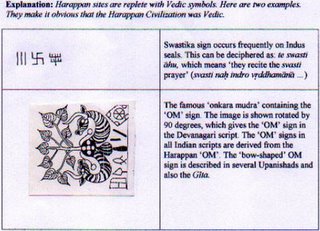
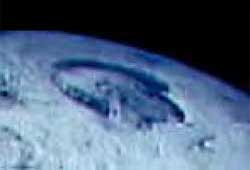
The Holes at the Poles
However, it is only comparatively recently that they have again captured public attention through the alleged NASA photographs of the so-called “Hole at the Pole”, which seem to lend some positive evidence to what had been suspected for centuries. Namely, that there has always been a hole or “portal” at either pole giving access to an inner Earth, somewhat akin to Rice-Burroughs famous “Pellucidar”, but with a highly advanced people and technology, instead of the wild, prehistoric surroundings, savages and animals with which Burroughs furnished his subterranean world!
Scholars have written about these polar holes for centuries, and it would take several pages to go through their theories and notions, so I will avoid retelling the many legends of these “entrances to the underworld”. Some suggested giant maelstroms, down which careless sailors could be swept. Others spoke of them as the portals of Hell itself. Yet others went so far as to describe fantastic voyages, whereby sailors entered at one pole and emerged safely at the other, after sailing an internal ocean and seeing a whole new world within, lit by a central sun. Science-fiction is no new thing. However, to return to our subject. Let us consider some of the more modern views on this fascinating concept.
THE D'ANNE BURLEY SHOW
FEATURED ON
HTTP:WWW.TRUTHRADIO.COM
MON - FRI 6PM
CENTRAL TIME
CALL IN 1-605-220-0900 EXT 619847
THE TEMPLE MOUNT
CONSPIRACY
AND
THE GOLD
OF KING SOLOMON
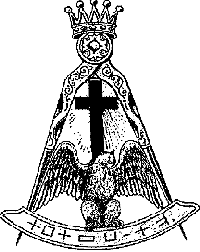
THE SIMBOLS - THE CROWN = KING THE SHIELD = MASONIC ORDER AND THE PROTECTOR OF GOD ON EARTH "THE KINGS AND QUEENS OF THE WORLD" THE ROBE = THE COVENANT THE CROSS = HOLY CHURCH "JESUITS" THE BEAST = GREAT SATAN OR SETI
The Vedic Language From India
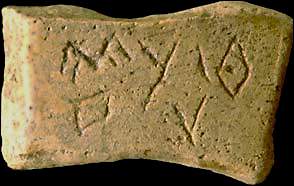 More than 5500 years old (3500 BC)
More than 5500 years old (3500 BC) World's oldest writing (Part 1): Vedic origins
The recently discovered nearly six thousand year old writing is related to the Rigveda. It demolishes long held theories like the Aryan invasion, the Aryan-Dravidian divide, and points to a continuous evolution of Indian Civilization - including writing - from prehistoric times to the present.
Oldest writing
The recently discovered sample of writing at the lower level of Harappa, among the oldest examples of writing known, if not the oldest, is a more primitive form of the Harappan script of the Indus Valley. In addition, it clearly refers to Ilavarta, according to the Rigveda the sacred land bounded by the Vedic rivers Sarasvati and the Drishadvati. This is my conclusion following a careful examination of the sample, and its comparison with the writing on more than two thousand Harappan seals, that N. Jha and I have deciphered. Jha has also examined the sample and concurs with me. Several Vedic scholars that I consulted agree with my interpretation of the writing also, and its historical significance. Here is the background.
There was great excitement in scholarly circles when Dr. Richard Meadow of the Peabody Museum at Harvard University recently announced the discovery of a piece of pottery at Harappa in Pakistan, with a written message on it. The discovery was announced on the BBC (among others) where it was stated to be more than 5500 years old (3500 BC), making it the oldest example of writing known, and about a thousand years older than the bulk of Harappan writing. I was able to examine it by accessing the BBC website on which the piece of pottery with the writing was displayed. Using the methodology that Jha and I have developed to read the Harappan seals, I was able to decipher the message as ilavartate vara, which means 'Ila surrounds the blessed land (vara or best)'. This was later confirmed by N. Jha, the key figure in the decipherment of the Harappan or the Indus script.
It was written in the very old scrolls within religous history the following:
Yahushua
Iesous ee-ay-sooce' of Hebrew origin (3091); Jesus (i.e. Jehoshua), the name of our Lord and two (three) other Israelites:--Jesus.

THE ONE GOD
BELIEF SYSTEM
RA
Note that Joshua = Yoshua or Yahushua because there is no "J" sound in Hebrew. The letter "J" is only about 500 years old and isn't even found in the original 1611 King James version.Shophetim 21:19 begins with the mention of "a yearly festival of Yahueh in
Shiloh". Zekaryah 14:16-19 tells us that during Yahushua's Millennial
Reign, all the nations of the earth shall go up to Jerusalem, to the House
of El, to celebrate the Festival of Booths - a prophetic rehearsal of the
time when Yahueh once again "pitches His tent" with man. The other Feasts
of Yahueh will have been fulfilled and the people keeping the Festival of
Booths during Yahushua's reign will be observing it as a rehearsal for the
days of eternity, when Yahueh and the Lamb shall abide in the midst of His
people in Yahueh Shammah, the New Jerusalem (Yehezeqel 48:35), when the new
heavens and the new earth have descended from the heavens above (Revelation
21-22).
The Christ
Young Years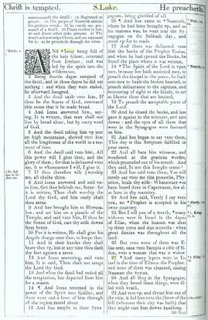 Jesus within Buddhism. It has been suggested that within Mahayana Buddhism the legendary Bodhisattva Avalokitesvara developed out of Jesus having been in Tibet and India. 44 For one reason, this bodhisattva is thought to have reached his earliest known (legendary) form around the second or third century C.E.,45 which timing is appropriate for the hypothesis. For another reason, the book by Professor John Holt of Bowdoin College, Brunswick, Maine, suggests that the origins of the Avalokitesvara cult was in northwest India in the second century.46 Although Avalokitesvara is mentioned in the Buddhist writing called the Heart Sutra, that writing, according to Holt (personal communication), is a "prajnaparamita" text that probably dates to either the 1st or 2nd century CE and is therefore somewhat later than the more likely origins of Avalokitesvara. The name itself, however, may stem from "avalokana," an abstracted mythologization of the compassionate view of the world that the Buddha takes just after his enlightenment experience.
Jesus within Buddhism. It has been suggested that within Mahayana Buddhism the legendary Bodhisattva Avalokitesvara developed out of Jesus having been in Tibet and India. 44 For one reason, this bodhisattva is thought to have reached his earliest known (legendary) form around the second or third century C.E.,45 which timing is appropriate for the hypothesis. For another reason, the book by Professor John Holt of Bowdoin College, Brunswick, Maine, suggests that the origins of the Avalokitesvara cult was in northwest India in the second century.46 Although Avalokitesvara is mentioned in the Buddhist writing called the Heart Sutra, that writing, according to Holt (personal communication), is a "prajnaparamita" text that probably dates to either the 1st or 2nd century CE and is therefore somewhat later than the more likely origins of Avalokitesvara. The name itself, however, may stem from "avalokana," an abstracted mythologization of the compassionate view of the world that the Buddha takes just after his enlightenment experience. For still another reason, given the impact that Jesus made in just a couple years of ministry in Palestine, due in no small measure to his ability to work miracles and prophesy, it would not be surprising that his further ministry during many post-crucifixion years of traveling outside of Palestine under different names would also have received acclaim, at least within oral tradition. The Bodhisattva Avalokitesvara is a candidate for this because he became the top one or two of all the numerous bodhisattvas in importance and degree of respect and worship accorded. 47 Within Buddhist thought, the successive Dalai Lamas are believed to be reincarnations of Avalokitesvara.
However, the primary reason is that he is sometimes portrayed with a small circular marking on the hand, which could represent a crucifixion scar.48 A similar marking, usually interpreted as the Buddhist wheel of life, is mentioned in a third-century writing to be imprinted upon the soles of his feet.49
The mythologization of Avalokitesvara became so extensive that he has even been considered the creator of the world. 50 This is surprisingly similar to Jesus being professed as part of the Godhead who was with God the Creator from the beginning. If both creation strories are considered to be myths, however, it is not surprising that the same man could have inspired both.
If Avalokitesvara should indeed be another name for Jesus, it is an example of a legend as yet known to only a few. But if it was known to be more than just a legend to some Buddhists at the time the name Avalokitesvara was bestowed, it is understandable that they would not wish to antagonize Christians by insisting Buddhism call him by the same name that Christianity uses.
The empty tomb on Easter morning and subsequent appearances of Jesus to his disciples and to a few others have provided some novelists, or writer-scholars, with incentive to explore the possibility of his survival of the crucifixion.1 This incentive has been furthered by the lack of documented examples of resurrection other than that supposed for Jesus first by Paul and then by the early Christian church. Unknown to many, however, is that various independent scholars have also postulated that Jesus survived the crucifixion for the same reasons. Also not well known is how widespread and credible the traditions are that point to Jesus, after surviving the crucifixion, having traveled with a few others through Anatolia and thence eastward to northern India and the Kashmir region. Here these topics will be summarized and consolidated so that open-minded, questioning Christians can better explore the roots of their faith and understand how thoroughly Christian authorities over the centuries have ignored, suppressed and belittled the unthinkable evidence that could overturn their faith.
(Psalm 127. A Song of Ascents. Of Solomon.)

Kings Come to Ancient Israel
After the conquest of the land and the death of that great leader Joshua, the tribes of Israel settled into the chaotic, disjointed, and disorganized period described in the Book of Judges. This whole time period of nearly four centuries was characterized by the repeated descriptive phrase, "In those days there was no king in the land, everyone did what was right in his own eyes." (Judges 17:6, 18:1, 19:1, 21:25) Failure to drive out and exterminate the corrupting Canaanites who lived previously in the land caused these peoples to grow back like poisonous weeds until they oppressed and harassed Israel. During this time God graciously raised up "judges" (shophetim) who reversed the status quo for a season by calling on God and rally the people around the One who had chosen them and
commissioned them to occupy the land. Moral and spiritual conditions were very low at Shiloh when the prophet Samuel was born. The Levitical priesthood under Eli was about to be disqualified in the deaths of Eli's disreputable sons Hophni and Phinehas. Although God had desired to rule Israel as their invisible Monarch and Lord, the people clamored for a national champion to rule them:
THE ONE GOD OF THE ARYAN
The original religion of the Aryans when they entered India is generally denoted Vedism or Brahmanism (after Brahma or the Brahmin caste), or Vedic Brahmanism. Vaishnavism is the only direct descendant of this religion. In the earliest Aryan texts we find Vishnu already rising to the status of the supreme Aryan god. The following is a summary of the evidence that the origins of Vaishnavism lie deep in early Indo-Aryan history, as well as being a proof that Vaishnavism is the direct descendant of the ancient Vedic-Brahmanic religion :
- Vishnu's 3 steps are mentioned in the Rig Veda [ RgV. VI.49.13 ] as the steps for Manu or man in distress.
- The Aitareya Brahmana I.1 calls Vishnu Parama ( highest ) 110-111
- The Katha Upanishad III.9 states that the goal of Human soul is Vishnu's abode of eternal bliss [ Katha Upanishad III.9 ] [ cf RV I.22.20 ] [ Sircar 110-111 ].
- There was once a contest among the gods as to who wass the greatest. Vishnu by his deeds reached the end of the sacrifice and won, and is referred to as the most excellent of the Gods [ Satapatha Brahaman XIV.1.1 ][ Taittriya Aranyaka V.1 Pancavimsa Brahmana VII.5.6] [ Sircar 110-111 ].
- Satapatha Brah. I.2.5 mentions the dwarf, fishand tortoise incarnations of Brahma [ cf Sat.Br.XIV.1.2, Taittriya Samh. VII.1.5; Taitt. Brha.I.1.3 ] ; these were not yet assoc with Vishnu but with Brahma [ Sircar 132 ] and on the subsequent absorption of Brahma into an incarnation of Vishnu, these became Vishnu's incarnations.
- The legend of Vishnu's head being severed from body to give rise to the Sun or aditya is already mentioned in the Brahmanas [ Satapatha Brahmana XIV.1.1 ].
The influence of Vishnusim on other religions has been considrable. The 24
incarnations of Vishnu inspired the concept of 24 Jain tirthankaras; Vishnu's sudarshan chakra was the model for the Buddhist Dharmachakra; and the notion of Vishnu's pada led to Buddha's footprint [ Sircar 130 ].
In general the relation of Islam and Vaishnavism was one of hostility. The Muslim rulers encouraged heterodox sects (Jainism, Shaivism) while at the same time demolishing Vaishnavite temples. Vaishnavism was dominant in India up to th
e time of the Muslims, and the entrance of Islam changed the balance in favour of the heretics.
Beneath the Surface of the Earth
Eventually, another French mystic investigator, Saint-Yves d’Alveydre, in 1886
revealed in his book “Mission of India”, that Agartha is a hidden land beneath the surface of the Earth, ruled over by a black sovereign Pontiff, called the Brahmatma. He goes on to say that the realm was shifted underground around 3,200 BC, at the beginning of the Kali Yuga (or Golden Age) and that Agartha has known technology such as artificial lighting, mechanised transport, and even air-travel, far in advance of our own modern technology, for millennia.
Periodically, Agartha sends emissaries to the upper world, about which it keeps astonishingly well informed. Agartha also has huge libraries which enshrine the whole wisdom of the ages, engraved in stone. Many great secrets lie there, regarding many esoteric and spiritual subjects, including ama
zing skills and abilities long-forgotten by those who dwell on the surface.
The Holes at the Poles
However, it is only comparatively recently that they have again captured public attention through the alleged NASA photographs of the so-called “Hole at the Pole”, which seem to lend some positive evidence to what had been suspected for centuries. Namely, that there has always been a hole or “portal” at either pole giving access to an inner Earth, somewhat akin to Rice-Burroughs famous “Pellucidar”, but with a highly advanced people and technology, instead of the
wild, prehistoric surroundings, savages and animals with which Burroughs furnished his subterranean world!
Scholars have written about these polar holes for centuries, and it would take several pages to go through their theories and notions, so I will avoid retelling the many legends of these “entrances to the underworld”. Some suggested giant maelstroms, down which careless sailors could be swept. Others spoke of them as the portals of Hell itself. Yet others went so far as to describe fantastic voyages, whereby sailors entered at one pole and emerged safely at the other, after sailing an internal ocean and seeing a whole new world within, lit by a central sun. Science-fiction is no new thing. However, to return to our subject. Let us consider some of the more modern views on this fascinating concept.
The vedic symbols and the swastika
Until the Nazis used this symbol, the swastika was used by many cultures throughout the past 3,000 years to represent life, sun, power, strength, and good luck.
